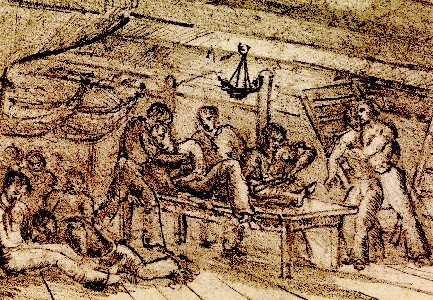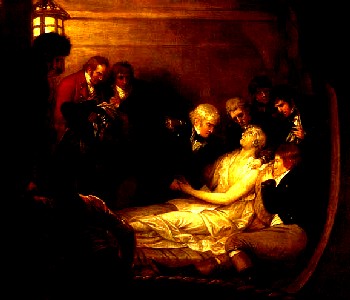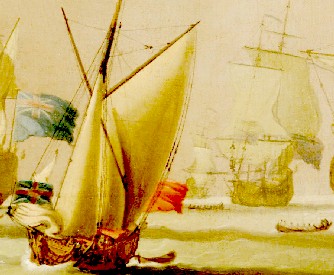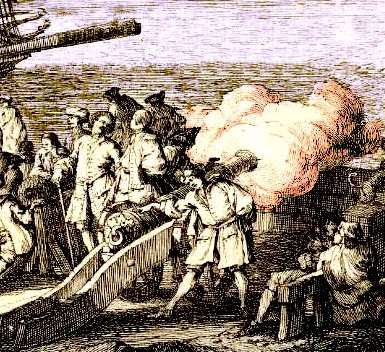
The Pirate Surgeon's Quarters: 1 2 3 4 5 6 7 8 9 10 11 12 Next>>
The Pirate Surgeon's Quarters in the Golden Age of Piracy, Page 1
"[T]he surgeon has every necessary article for his practice, but [he has] not conveniences for applying them with facility to use." (Sea Surgeon Robert Young's Journal, 1797, quoted by Kevin Brown, Poxed and Scurvied: The Story of Sickness and Health at Sea, p. 92)
The surgeon on a ship had several chests and boxes that he carried with him along with various daily duties preparing medicines - salves, ointments, pills and liquid - as well as plasters, bandages and other dressings for application to the sick and wounded. During battle and emergencies such as fierce storms at sea, he had to be in the most protected place possible to operate which also provided enough room to put patients being brought to him for treatment.
Unfortunately, little was written about the location and conditions of the place where the surgeon worked
on a merchant ship, much less a pirate ship during the Golden Age of Piracy. More has been found in the journals and

Ship's Surgery in the Cockpit - early 19th Century, Unknown Artist, from
The National Maritime Museums,
Greenwich, London (1820)
writings of the late 18th and early 19th century in the British Navy. With this in mind, the sections of this article concerning the operating area will draw more upon later references than usual.
If anything, the conditions in the surgery had improved somewhat. Several edicts passed between the golden age of piracy and the late 18th/early 19th century that talked about problems of the surgeon's location on a ship.
For example, in 1730 (five years after the golden age of piracy as used by this website) a List of Regulations and Instructions relating to Service at Sea was "published by His Majesty's command"1 which contained Rules for the Cure of Sick or Hurt Seamen on board their own Ships.
The first article was "That convenient room shall be made between Decks in all His Majesty's Ships, for the Reception of sick or hurt Seamen, whither they are to be removed with their Hammacoes and Bedding when the Surgeon shall advice the same to be necessary."2 The second articled noted that the captain had to "appoint some of the Ship's Company to attend and serve the Sick Men Night and Day by Turns and to keep the Place clean."3

Artist: Brian West
The Death of Lord Nelson - Showing the Ship's Cockpit (1808)
Space on most ships was a precious commodity. Yet surgery, daily medical preparations and the laying out of the tools required for operations required space. So while the sailor's and navy's interest in having surgeons on board to minister to the men was high, providing adequate accommodations was challenging. British Royal Naval sea-surgeon Robert Young had much to say about the shipboard conditions in the Medical Journal he kept from May 1797 through April 1798.
Young revealed that while "[t]he storeroom for his lime juice and surgeon's necessaries was usually far too small, and that 'for making up and keeping at hand a regular formula of extemporaneous medicines, for having everything he may want ready of access, his instruments, lint, needles, his lotions, dressings, pills he has no convenience whatever.'"4
He further explained that every warship had "a large store room was allotted to the surgeon and in it a well contrived dispensation fitted up on a plan to become part of the establishment of this department all which might very well be done in small and in such rooms as could easily be spared, a counter with drawers below and smaller drawers and guarded shelves for bottles etc, I am convinced it would be more to a surgeon on a large ship than one of his three or four mates."5 Keep in mind that this was written by a man on a British navy vessel which was usually much larger than those used by the pirates.
1 Sir Cecil Wakely, Surgeons and the Navy, transcript of Thomas Vicary Lecture delivered at the Royal College of Surgeons in England, 11/14/1957; 2 Great Britain Privy Council, Regulations and Instructions Relating to His Majesty's Service at Sea, 9th Ed., p. 55; 3 Ibid; 4 Kevin Brown, Poxed and Scurvied: The Story of Sickness and Health at Sea, p. 92; 5 Jonathan Charles Goddard, "An insight into the life of Royal Naval surgeons during the Napoleonic War, Part II," Journal of the Royal Naval Medical Service, Spring 1992, p. 28
Vessels
"Oh, the Dauntless is the power in these waters, true enough, but there's no ship as can match the Interceptor for speed." -Murtogg to Captain Jack Sparrow, Pirates of the Caribbean: Curse of the Black Pearl
Yes, unbelievable as it may seem, we lead off this section on ships with a quote from the Pirates of the Caribbean movie because they actually got that bit right - one of the primary things a pirate wanted in a ship was speed - so when Captain Jack was able, he stole the Interceptor.

British Royal Navy Ship Ratings - calculated
from
Rating system of the Royal Navy, wikipedia, gathered 11/3/12,
1706 Establishment, wikipedia, gathered 11/14/12
and
1719 Establishment, wikipedia, gathered 11/14/12
Note that when counting gun decks, the quarterdeck and
forecastle, both
of which mounted guns, are not included.
*Thanks to David Fictum for pointing me to this information.
Using this fictional example as a proxy for the real world, the Dauntless was a British Royal Navy First Rate Ship-of-the-Line with 100 guns1 while the Interceptor was a BRN Brig with 16 guns and two swivel guns.2 Naval ship ratings during the golden age of the pirates were rated based on the number of guns they carried. The chart at right shows the ratings for each class of ship during the Napoleonic era.
While it would be nice to have a large, imposing ship of 100 guns, speed gave pirates a significant advantage during pursuit, maneuvering and, when needed, retreat. David Cordingly lists speed as being the most important thing pirates desired in a vessel. Next in importance were seaworthiness and armament.3
Seaworthiness was crucial because of the roving nature of many pirates. Pirate commodore Edward Low crossed the Atlantic Ocean several times and made trips from the Caribbean up to Newfoundland and back again. During his travels, he ran into a hurricane which sorely tested the fitness of his brigantine and schooner4, hinting how much a well built and maintained vessel could mean to a pirate crew.
Weaponry would seem to be the most important part of the ship based

Artist: Peter Monamy
A sloop amidst British Men-of-War and longboats (1720s)
on what many of the pirate movies suggest, but each mounted cannon required a crew of 4-6 men to operate. If we do the math using the fictional HMS Dauntless (a warship of 100 guns) the ship would require 400 - 600 men. A real-life 100-gun British Navy ship from the golden age of the pirate - the Britannia, the flagship for the English fleet in the 1690s - had a crew of 780 men!5
Interestingly, even the Royal Navy didn't see a need to send such a large ship to the New World, despite the movie character's stated enthusiasm for their 100 gun ship. As historian Peter Earle explains with regard to the period just before the golden age of piracy, "The largest [naval] ships to be used in anti-piracy duty were fourth-rates, ships with at least forty guns and often more in the late seventeenth century, while most of the service was done by fifth-rates (usually thirty to forty guns) and sixth-rates (twenty to thirty guns), the number of guns for each rate tending to rise over time. There were also some smaller unrated vessels employed, such as sloops and ketches."6 This sort of destroys our movie example.
Although our romanticized vision of piracy today suggests that everyone would want to join a pirate crew given the chance, such was not really the case. David Cordlingly suggests that some pirates had 150 -200 men aboard5, this would be far less than required to man such a battery of weapons.
a
Artist: Jacques Rigaud Jacque
Firing Cannon, From Alere au Depart Avec Coup de Canon (1750)
Such crews, if stretched, could work 37 - 50 guns. There are some examples of pirates having had more men than what Cordingly mentions. Based on data collected on the pirate ships active between 1690 and 1725, Bartholomew Roberts is reported to have had at one times 3107-400 men8, Blackbeard is said to have had 3009-35010, the Speaker, captained by both George Booth and John Bowen was suggested to have 260 men11 and Samuel Bellamy's Whydah may have had as many as 25012. However, given that most of these reports were from newpaper accounts, their accuracy can be justly questioned.
Another problem with cannon was that they were heavy and would weigh the ship down, meaning she would not sail as quickly. As Cordingly explains, "The armament of the selected vessel was less important than speed and seaworthiness because guns could always be added later."13
So if most pirates weren't sailing around in large warships bristling with cannon, what were they using? Pirates' vessels can be broadly divided into two types of craft: large and small. A pirate's 'large' ship was nearly always smaller than a British Royal Navy 'ship-of-the-line' - those identified as being Class 1, 2, 3 or 4 ships, mounting 50 guns or more.14 A pirate's 'small' boat was usually a vessel with one or two masts and a similar number of decks. In Royal Navy parlance, these craft would have less than 20 guns.15
Let's look at the different kinds of ships which pirates used - both large and small.
1 HMS Dauntless, Pirates of the Caribbean wiki, gathered 11/9/12; 2 HMS Interceptor, Pirates of the Caribbean wiki, gathered 11/9/12; 3 David Cordingly, Under the Black Flag, p. 158; 4 Captain Charles Johnson, The General History of the Most Notorious Pirates, p. 370; 5 British first rate ship of the line 'Britannia' (1682), threedecks.org, gathered 11/14/12 & Email discussion with David Fictum, 11/13/12; 6 Peter Earle, The Pirate Wars, 2003, p. 136; 7 Post Boy, 1-18-22 - 1-20, Issue 5070; 8 The Weekly Journal or Saturday Post, Saturday January 13. 1722; 9 CSPC America and West Indies, Vol. 30, Item 551; 10 Ed Fox, “74. Lists of ships taken by pirates, Pirates in Their Own Words, 2014, p. 385-6; 11 The Boston News-Letter, From Monday June 9 to Monday June 16, 1718; 12 Daniel Defoe (Captain Charles Johnson), A General History of the Pyrates, Manuel Schonhorn, ed., 1999, p. 479; 13 Cordingly, p. 165; 14 Cordingly, p. 159; 15 Rating system of the Royal Navy, wikipedia, gathered 11/3/12, 1706 Establishment, wikipedia, gathered 11/14/12 and 1719 Establishment, wikipedia, gathered 11/14/12; 9 Ibid.

